Anno MMXXIV Aurorae Borealium
Tagged:Beauty
/
Physics
A major solar coronal mass ejection has resulted in generational-sized geomagnetic storms on Earth. Also, glow-thingies in the sky.
Sun: Big Zit
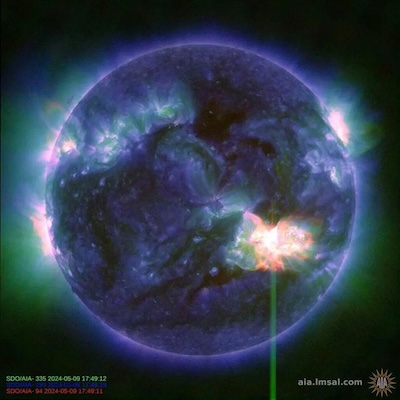 The Sun has weather, in the form of magnetic storms, sunspots, and giant Coronal Mass
Ejections in which it spews huge amounts of solar plasma off into space. That’s what’s
happened this last week. Here you can see an image of the Sun (not in visible light,
obviously) on 2024-May-09. The giant bright spot in the lower right is a giant sunspot,
about O(105) km across – about 15x the diameter of Earth. That’s our new friend,
sunspot AR3664.
The Sun has weather, in the form of magnetic storms, sunspots, and giant Coronal Mass
Ejections in which it spews huge amounts of solar plasma off into space. That’s what’s
happened this last week. Here you can see an image of the Sun (not in visible light,
obviously) on 2024-May-09. The giant bright spot in the lower right is a giant sunspot,
about O(105) km across – about 15x the diameter of Earth. That’s our new friend,
sunspot AR3664.
You can look at the relevant images yourself, playing around with the time and the wavelength window at the Lockheed-Martin Solar Astrophysics Laboratory site. You’ll have to go ahead and fool around with the controls yourself to get to 2024-May-09 in the afternoon.)
The resulting solar storms are divided into classes called B, C, M, and X. Each class has 10x the energy of the previous. This one is class X4, i.e., honkin’ huge. This is the sort of thing one sees once in a generation, or longer.
That results in a geomagnetic storm on Earth: huge electric fields sustained in the magnetosphere, and even down to the surface. Big enough and it’ll take out long-haul power lines, which just look like big receiving antennas getting fried by the power thrown at them. Big enough and they take out satellites. This one is class G4 according to NOAA and the Space Weather Prediction Center; if it had gotten to G5 for very long it would have taken out satellites. Again, once in a generation.
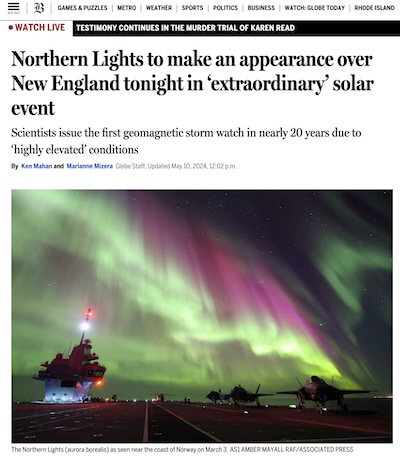 The venerable Globe has an explainer [1] that’s worth your
time. They’ll point you at NOAA, the Space Weather sites, explain sunspots, coronal mass
ejections, and geomagnetic storms.
The venerable Globe has an explainer [1] that’s worth your
time. They’ll point you at NOAA, the Space Weather sites, explain sunspots, coronal mass
ejections, and geomagnetic storms.
They spend most of their time explaining what the impact on Earth will be (q.v.), from our somewhat parochially human viewpoint. It’s hard to convey how extreme events like this are, and how much solar astronomers want to get their instruments set just right to record it. The Sun is ejecting flares of X-rays and some huge streams of sun-stuff in spiral waves that will soon reach Earth and tell us all kinds of things about solar physics.
Oh, and if we’re lucky it’ll only take down our comsats and electrical power distribution grid. (Back in the 60s, people used to worry about accidental nuclear launches. Fortunately, all that stuff is (a) smaller now, and (b) hardened appropriately.)
Aurora Borealis
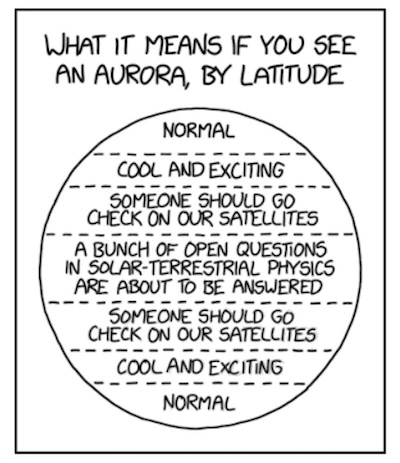 As per the customs of our tribe, XKCD has the correct interpretation, shown here.
Seeing aurora borealis (Latin: “dawn of the north”, plural “aurorae borealium”, southern
hemisphere version “aurora australis”) at high latitudes is entirely ordinary. Seeing it
at lower latitudes is at first rare, then exciting, then… well, check for damage to
satellites and power lines. I think at this point we’re in the “exciting” range, as no
damage seems to have been reported after the fact.
As per the customs of our tribe, XKCD has the correct interpretation, shown here.
Seeing aurora borealis (Latin: “dawn of the north”, plural “aurorae borealium”, southern
hemisphere version “aurora australis”) at high latitudes is entirely ordinary. Seeing it
at lower latitudes is at first rare, then exciting, then… well, check for damage to
satellites and power lines. I think at this point we’re in the “exciting” range, as no
damage seems to have been reported after the fact.
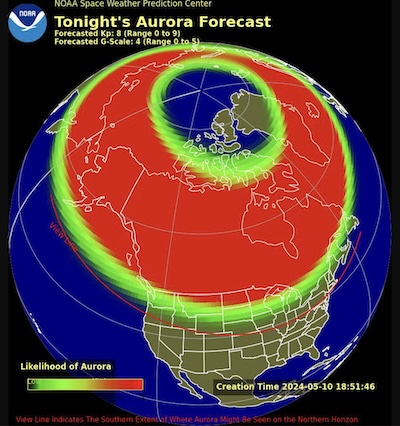 Usefully, the venerable Globe also reported this map, showing where to expect aurorae.
As you can see, it’s normally a polar affair. (Extra points: explain why it’s not seen
exactly at the magnetic pole, but only in a band around it. Hint: Think of the
direction of the magnetic field and the direction of the incoming plasma. What’s the
cross product?)
Usefully, the venerable Globe also reported this map, showing where to expect aurorae.
As you can see, it’s normally a polar affair. (Extra points: explain why it’s not seen
exactly at the magnetic pole, but only in a band around it. Hint: Think of the
direction of the magnetic field and the direction of the incoming plasma. What’s the
cross product?)
The big red band covering substantially all of Canada (hi, Canadians!) is the prime viewing area. So we’re not in that band, but here in New England we’re at least on the outer fringes of visibility (see the thin red line just south of Massachusetts).
I got really excited about this! The Weekend Editrix had just had a COVID-19 booster, and so was more interested in sleep. I got out to look up at the sky… well, see below.
The physics of an aurora is quite complex. I’m not terribly surprised; it seemed to me way back in grad school that everything that touches astrophysics is a complex gemisch of everything possible. In astro, you can only take observations, not conduct highly controlled experiments. So none of the “clean” interpretations you can get in the lab.
Still, Kyle Cranmer provided a nice little explainer on social media of what’s going on. Basically, air is mostly nitrogen and oxygen. Depending on which molecule you’re hammering on, and at what pressure, you get various colors:
Les Pics!
Ok, enough nattering on about physics. What did it look like?
Alas, it was cloudy both nights here at Château Weekend. Also, considerable urban light pollution; we might be in suburbia but not in the “ultra-boonies”, as they were called during my mis-spent childhood.
However, other people had better luck. Here’s a dramatic photo, via
mathstodon.xyz (my favored social media hangout with fellow math
nerds), from Joseph Andriano taken 2024-May-10 @ 10:40pm near the Vermont state house:
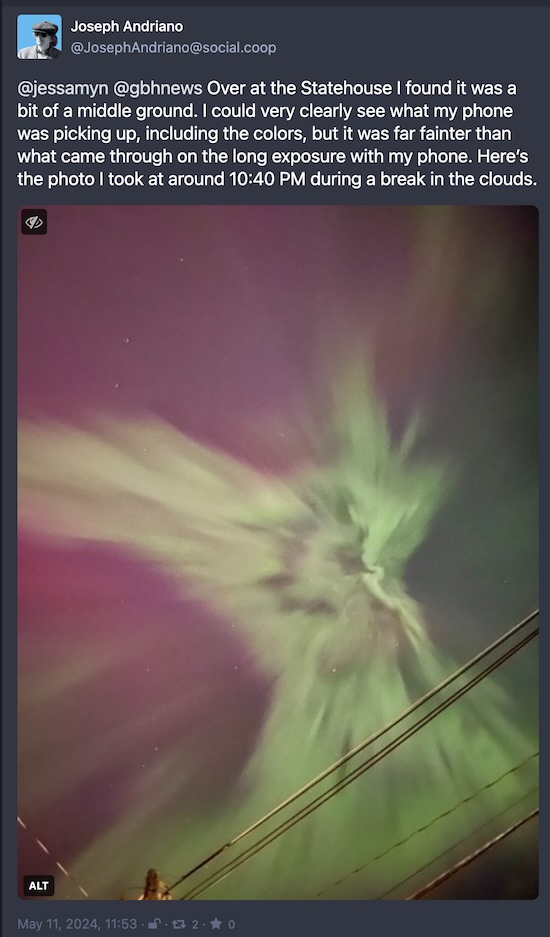
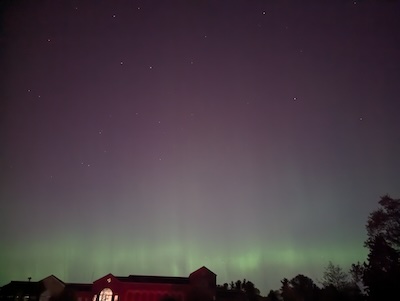
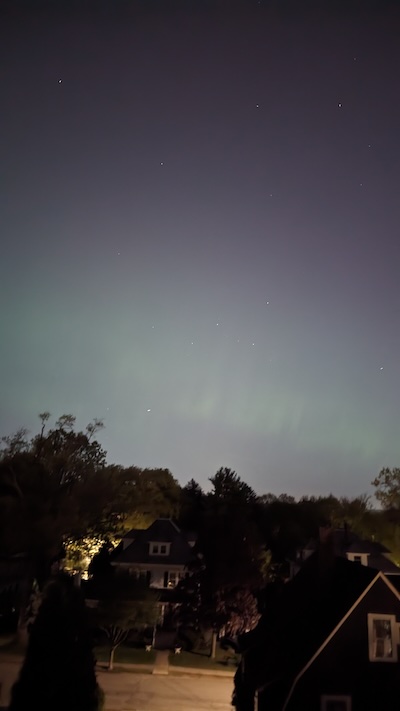 Here are some rather more local pictures, taken by a friend & his son (reproduced with
permission).
Here are some rather more local pictures, taken by a friend & his son (reproduced with
permission).
Having been warned this was happening by your humble Weekend Editor, they first drove out to Acton, MA (“deepest, darkest, exurbia”, about 20 mi NW of Boston) and found a high school athletic field where the lights had been turned off.
At the bottom, you can see some of the building lights were still on. The aurora here is low on the horizon, because most of the activity is much further north – so you have to look at the atmosphere further north, not so much the atmosphere above you. It’s primarily green, so we’re seeing mostly the action on monatomic oxygen at mid-altitude/higher pressures (up to ~ 240km). I wasn’t there, so I can’t say what it looked like in real time, but it probably wiggled a bit like the bottom of a giant curtain. Cognoscenti may possibly be able to identify Polaris here.
Note that this is not exactly what one sees with the naked eye. The night vision on a good cell phone camera has much better than human capability! At first they thought there was nothing much happening, but their cameras told another story.
Upon returning home to deepest, not-so-darkest suburbia just west of Boston, they wondered if anything would be visible here. To the naked eye, there was nothing. But a phone camera from a north-facing bedroom window, looking at the horizon, found the second picture shown here (a little blurry from a hand-held longer exposure). Clearly there’s a faint green curtain of light – mid-altitude oxygen again – just peeking through the city lights.
They apparently took this much later than when I looked, since all the clouds had cleared.
The Weekend Conclusion
Nature is beautiful.
The more physics you know, the more deeply you can appreciate that beauty.
We, as humans, should also attempt to behave in morally beautiful ways so as to deserve the world’s beauty.
(Ceterum censeo, Trump incarcerandam esse.)
Addendum 2024-May-14: Portland Head Light in Maine
Here’s a beautiful photo tweeted by photographer Benjamin Williamson (@photographmaine), taken at Cape Elizabeth in Maine, at the Portland Head Light:
Being a little bit further north helps a little.
Being a professional photographer helps a lot!
Notes & References
1: K Mahan & M Mizera, “Northern Lights to make an appearance over New England tonight in ‘extraordinary’ solar event”, Boston Globe, 2024-May-10. ↩

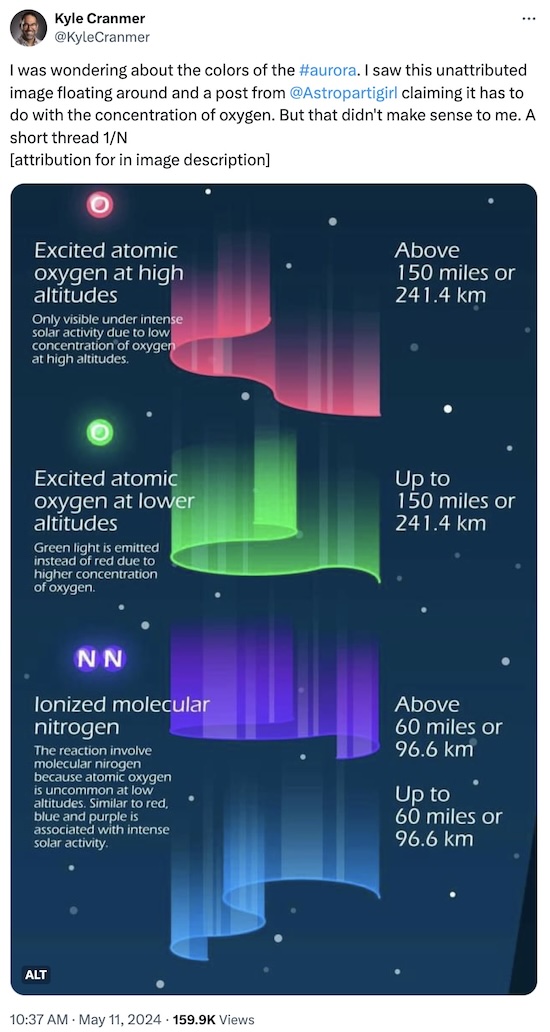
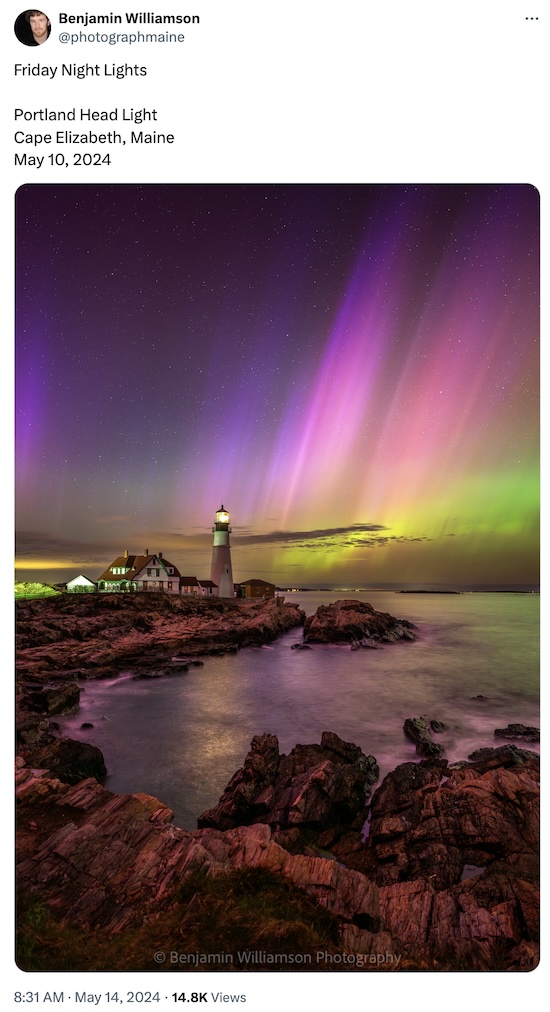
Gestae Commentaria
Comments for this post are closed pending repair of the comment system, but the Email/Twitter/Mastodon icons at page-top always work.